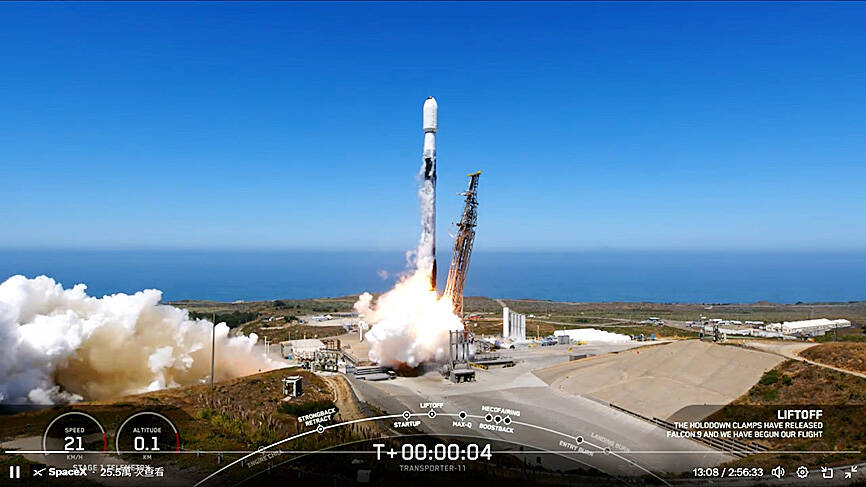A Space Exploration Technologies Corp (SpaceX) Falcon 9 rocket on Friday carried two Taiwan-developed satellites into orbit, along with 114 others, the Taiwan Space Agency (TASA) said.
The two “cube satellites” or CubeSats — Toro and Nightjar — were launched into space at 11:56am from Space Launch Complex 4E at Vandenberg Space Force Base in California on the Transporter-11 rideshare mission, TASA said.
Toro and Nightjar entered orbit at about 2:30pm, the agency said.

Photo: Screen grab from livestream via the Taiwan Space Agency
CubeSats are a class of small satellites made up of multiple cubic modules each measuring 10cm on a side and weighing up to 1.3kg that have a wide range of applications and are increasingly relevant in the aerospace industry.
Toro and Nightjar are both 30cm by 10cm by 10cm, TASA said.
Compared with traditional satellites, the CubeSats business has a relatively low entry threshold in terms of cost and technology. As they are smaller and lighter, a rocket is able to carry many CubeSats at the same time, making them a good option for those in the private sector wanting to enter the aerospace industry.
Toro, which was developed by satellite communications product supplier Pyras Technology Inc (芳興科技), carries a payload of cameras that are to photograph the ocean over four hot spots in the equatorial region to analyze changes in the water’s color and enable the completion of fishing ground positioning, TASA said.
Thanks to Toro, Taiwan’s aerospace technologies are expected to serve the country’s fishing industry well, using positioning technologies, marine communications and fleet management, as Pyras Technology has worked hard conducting field surveys in oceans to meet market needs, the agency said.
Toro is expected to help the fishing industry find ocean resources, it added.
Pyras Technology has been working on developing satellites, such as Formosat-1, with TASA since the 1990s, when it was called the National Space Organization, the agency said.
Pyras Technology has also worked with foreign space and military organizations to develop satellite components, TASA said.
Nightjar, developed by antenna designer and radio frequency testing manufacturer Rapidtek Technologies Inc (鐳洋科技), carries a payload of Ku-band high-speed Internet of Things communications services, and its mission is to test communication links between satellites and fixed user terminals or high-speed moving user terminals on the ground, TASA said.
If the two CubeSats work well and get certified, it would open the door for Taiwan to develop satellite engineering and compete in the commercial aerospace industry, it said.
TASA in 2022 launched a 10-year satellite innovation program focusing on the development of CubeSats. The program has four phases. Pyras Technology and Rapidtek Technologies are part of the second phase of three years, which started last year. The first phase was a one-year preparation phase. The third and fourth phases are to last three years each.
The two companies and Tron Future Tech Inc (創未來科技), which provides active electronically scanned array technologies for communications equipment, are developing larger CubeSats that are 40cm by 20cm by 20cm.
The launch of the first of these CubeSats is scheduled for next year, TASA said.

‘DANGEROUS GAME’: Legislative Yuan budget cuts have already become a point of discussion for Democrats and Republicans in Washington, Elbridge Colby said Taiwan’s fall to China “would be a disaster for American interests” and Taipei must raise defense spending to deter Beijing, US President Donald Trump’s pick to lead Pentagon policy, Elbridge Colby, said on Tuesday during his US Senate confirmation hearing. The nominee for US undersecretary of defense for policy told the Armed Services Committee that Washington needs to motivate Taiwan to avoid a conflict with China and that he is “profoundly disturbed” about its perceived reluctance to raise defense spending closer to 10 percent of GDP. Colby, a China hawk who also served in the Pentagon in Trump’s first team,

SEPARATE: The MAC rebutted Beijing’s claim that Taiwan is China’s province, asserting that UN Resolution 2758 neither mentions Taiwan nor grants the PRC authority over it The “status quo” of democratic Taiwan and autocratic China not belonging to each other has long been recognized by the international community, the Mainland Affairs Council (MAC) said yesterday in its rebuttal of Beijing’s claim that Taiwan can only be represented in the UN as “Taiwan, Province of China.” Chinese Minister of Foreign Affairs Wang Yi (王毅) yesterday at a news conference of the third session at the 14th National People’s Congress said that Taiwan can only be referred to as “Taiwan, Province of China” at the UN. Taiwan is an inseparable part of Chinese territory, which is not only history but

CROSSED A LINE: While entertainers working in China have made pro-China statements before, this time it seriously affected the nation’s security and interests, a source said The Mainland Affairs Council (MAC) late on Saturday night condemned the comments of Taiwanese entertainers who reposted Chinese statements denigrating Taiwan’s sovereignty. The nation’s cross-strait affairs authority issued the statement after several Taiwanese entertainers, including Patty Hou (侯佩岑), Ouyang Nana (歐陽娜娜) and Michelle Chen (陳妍希), on Friday and Saturday shared on their respective Sina Weibo (微博) accounts a post by state broadcaster China Central Television. The post showed an image of a map of Taiwan along with the five stars of the Chinese flag, and the message: “Taiwan is never a country. It never was and never will be.” The post followed remarks

INVESTMENT WATCH: The US activity would not affect the firm’s investment in Taiwan, where 11 production lines would likely be completed this year, C.C. Wei said Investments by Taiwan Semiconductor Manufacturing Co (TSMC, 台積電) in the US should not be a cause for concern, but rather seen as the moment that the company and Taiwan stepped into the global spotlight, President William Lai (賴清德) told a news conference at the Presidential Office in Taipei yesterday alongside TSMC chairman and chief executive officer C.C. Wei (魏哲家). Wei and US President Donald Trump in Washington on Monday announced plans to invest US$100 billion in the US to build three advanced foundries, two packaging plants, and a research and development center, after Trump threatened to slap tariffs on chips made